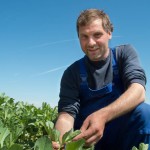Farm description
The Bioland farm Kreppold lies 500 m above sea level and has, with an average annual temperature of 7,5⁰C a mean annual rainfall of 750 mm. In the total of 112 ha sandy to loamy soils cereals and legumes (64 ha), grassland (20 h), root crops (23 ha) and field vegetables (5 ha) are cultivated. Focal points of operation are arable farming and suckler cow husbandry (40 GV).
Statements of the farmers
Johannes Kreppold, Bioland farm Kreppold, Wilpersberg
Climate change mitigation and adaptation is the essential topic of our time, to which organic farming plays forerunner role. Through participating the SOLMACC-Project and the results thereof I want to gain a feeling for right balance between reasonable yields and C-sequestration. The results of the project shall be used on my farm for possible improvement.
Climate friendly practices applied
- Improved on-farm nutrient management
Forage-manure cooperation and composting of on-farm residues
Third cut of forage legumes is collected by a nearby organic livestock farm. In exchange 10-15 m3/ha cattle slurry is brought back to croplands. With this practice N2O emissions from mulching are avoided, N fixation of forage legumes is increased and organic fertilisation of croplands enables better yields and C sequestration. Composting is performed with cattle manure and garden waste from private houses. Due to the regular turning of the compost piles, CH4 emissions are reduced. Regular compost application contributes to C sequestration in soil.
- Optimised crop rotations with legumes
Introduction of grain legume mixtures and maintenance of existing forage legumes
Farm introduced soy beans in recent years. Including other grain and forage legumes the proportion of legumes in crop rotation is 34%. Legume crops contribute to N fixation (reduction of N2O emission) and C sequestration.
- Optimised tillage systems
Reduced tillage and undersown crops
Farm avoids ploughing after grain legumes. Furthermore, basic tillage operations are avoided for grass-clover due to undersown clover in sunflower. By employing these practices diesel consumption will be reduced along with humus accumulation in soil (C sequestration).
- Agroforestry
Hedgerows and tree strips along agricultural fields
The farm installed hedgerows and tree strips, along with 6 ha forest which lead to C sequestration in above- and belowground biomass and in soil. Part of the woody biomass is used for composting and the energetic use of wood chips replaces fossil fuel (CO2 mitigation).
Location
Other farms
